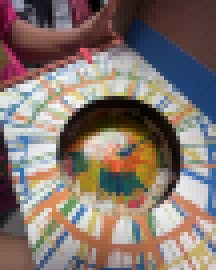Cesar Chavez Ravenswood Middle School (CCRMS) in East Palo Alto is named after the famed Mexican-American labor leader and civil rights activist. This tribute is fitting, given that the majority of the school’s students identify as Hispanic or Latinx. Community pride is evident here, but inherent language barriers in the student population and many socio-economic challenges require that teachers like Salvador Sainz stay laser-focused on ensuring equitable access to educational opportunities.
Sainz is in his sixth year teaching math and science at CCRMS, where he draws inspiration from his students and is conscious of the impact he feels he can have on the community. He’s always seeking new ways to engage his class and create better connections to curriculum standards. So, when he had the opportunity to introduce STEAM kits from KiwiCo into his sixth-grade classroom, he jumped at it.
The class received a set of Spin Art kits from the Tinker Crate line, designed to introduce concepts such as centripetal force, resistors and momentum—with a dash of artistic flair. Students begin by assembling simple circuits that power a spinning table. Once completed, they can use included paint droppers or their own supplies to make artwork. We spoke with Sainz recently to learn about the benefits of this playful approach to bringing STEAM learning into the classroom.
EdSurge: How did your students respond to the Tinker Crate?
Sainz: Honestly, it was such a great experience. The class had a good time building the spin art device and going through that engineering process of creating something. They were just fascinated by it.
It was also great to see them really take risks, which is so important at this age. It’s always a question of, “Do you feel comfortable taking a risk?” Because you don't want to embarrass yourself in front of others if you make a mistake, but we want risk-takers. It's okay to make mistakes. We're trying to build that identity.
And there were some kids who almost gave up midway. But this was a good lesson in productive struggle, understanding that, when building something, it might not always work out the first time. You just need a little support to make those connections, to be more successful the next time.
Eventually, some kids started to go at their own pace and build on their own. They took the assignment to heart—building and following directions and creating using electronics. They enjoyed it wholeheartedly, and they say they want to do it again.

Did this type of activity help you engage your students in a different way than you had previously?
Definitely. In the first couple weeks of the school year, there were some kids who were a little shy, more reserved, but this was their jam. They were excited to be able to show what they could do. At home, they work with LEGO or other types of kinetic building, like train sets. So, they felt very empowered because they identified with this kind of activity, and they were able to take on more of a leading role and build and move ahead independently.
There were definitely some kids—even some who were only Spanish speakers—who, at that moment, came out of their shells and really excelled in this assignment. I had a kid who finished in 40 minutes compared to the 80 minutes which most kids finish in. He asked, "What do I do now?" I suggested, “Maybe you want to support other students, help them out.” I could see for this student that this is the type of activity where he's going to excel. And I noticed that he’s now more participative in math and in science, starting to talk a little bit more and gain more confidence in class.
This was also a good activity for those kids who aren't signed up for art classes but really enjoy being creative. I have a lot of kids who draw, and it's really cool to engage this different way of thinking and connect it to science. You have to understand the wheel and the engineering aspect that's causing the paint to move in a circular pattern.

You mentioned your Spanish-speaking students. How did these materials work for them?
Some of the Kiwi Crates come with translated directions. This one was not translated into Spanish, but that was okay. That shouldn't be a barrier for students to be able to participate. And that's why I appreciated the visuals.
I had the video directions on the TV to add visual cues as well. The video instructions supported our Spanish-speaking kids, as well as some of our visual learners. Instead of me giving directions through voice every single time, kids used the video as well as the color-coded instructions with pictures and with words. I definitely appreciated that.
What sort of impact do these playful learning tools have in a classroom setting?
It’s very powerful for kids to be engineers in their own space. We don't want teachers to always lead the exploration; we want kids to do most of the exploration and make connections. We're just there to facilitate.
I loved the Kiwi Crates. Honestly, I would probably buy eight or nine different crates and do one a month, if we could tie them to the curriculum and get our kids to relate more to design and building. Those engineering principles will help them as they move into seventh and eighth-grade projects.
It’s also a great community-building activity when kids are able to work in pairs. And for the kids who were struggling on their own, this was a good way to support them. I saw a lot of my students helping each other out, which is awesome. Kids who were able to go ahead would say, "Oh, this is how you do it." It was only about two weeks into the school year when we did this activity. So, a lot of kids still didn't know each other's names yet, since they came from different schools. It was really cool for them to be able to help each other and be comfortable doing that.



